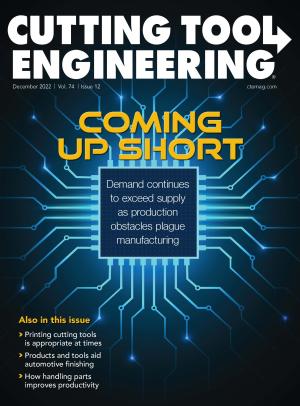Machine shops large and small are struggling with unprecedented labor shortages and economic pressures.
If governmental publications are correct, we will continue to face labor shortages into the foreseeable future because not enough skilled craftspeople are in the pipeline to support demand.
Economic pressures as a result of inflation and bottlenecked supply chains are driving up costs, pulling down margins and exacerbating labor shortages. Now more than ever, machine shops are seeking ways to increase productivity and reduce costs without additional labor.
Machinists and engineers usually respond to the need for improved productivity and lower costs by trying to machine parts faster. We often default to new drills, endmills or other tools that make chips more quickly, and most of the time these things provide productivity gains.
However, machining faster seldom closes the entire cost gap and has almost no impact on labor constraints. If we are going to significantly impact productivity and close labor gaps, machine shops must find more creative solutions.
Military science presents the concept of a force multiplier, which is defined by the Cambridge Dictionary as “something that increases the effect of a force.” Modern shops need to find tools and technologies that allow machinists to complete more value-added work without increasing the necessary resources. We need to find force multipliers. Taking advantage of them at a machine shop is the most effective way to reduce costs through improved productivity.

Everyone knows that the only time a machinist is productive is when a machine makes chips. Chip making is value-added time. We all agree that setups, tool changes and all similar activities, necessary or not, are non-value-added time. Anytime we can give a tool to a machinist that allows him or her to effectively conduct multiple simultaneous operations, we have created a force multiplier.
One of the most effective and often overlooked strategies to improve productivity is reducing non-value-added time invested in raw materials. Preparing them for machining operations is usually a lower-skilled job with generous tolerances, making them perfect for applying creative tools as force multipliers.
Automating cutting operations by using an automatic saw is the easiest, fastest way to add a force multiplier at a shop. Sawing is the most common method for turning raw materials into workpieces. Adding an automatic bandsaw or cold saw to a machine tool lineup immediately returns dividends by freeing people to perform more complex jobs.
More effective than automatic sawing is to separate a workpiece from raw material at the machine tool. A good example is adding a bar feeder to a lathe, which is a very simple but effective way to eliminate sawing operations. Bar feeders are common, and most new CNC lathes come wired for bar feeders.
If you can’t justify the expense of a bar feeder, use a bar puller. A bar feeder is an external tool that pushes the bar through the machine spindle. A bar puller is mounted on the turret and, as the name implies, pulls the bar through the spindle. Pullers are very straightforward devices that cost only a few hundred dollars whereas a good bar feeder costs many thousands of dollars. In a pinch, a good machinist can make a puller with materials from the shop in a couple of hours.
One of the more creative solutions that I have seen was a vertical machining center set up to bar-feed — without a bar feeder. The shop used a small CNC mill to cut parts out of square stock. The stock was clamped in a 5C collet held in a fourth-axis rotary device. Once a part was complete, the VMC would use a small saw blade to cut through the part, which would fall on the table. The VMC then would drill a hole into the square bar. With the drill inside the hole, the collet would unclamp and the VMC would pull the bar through the collet to start a new part. This way, the machine would run unattended, allowing the machinist to perform other tasks. It cost almost nothing to automate this process.
Robotic loading and unloading are becoming increasingly common at shops. When done well, robotic loading is extremely efficient. With recent advances in robotics, there is a lot of flexibility that didn’t exist with robotic technology in the past.
At a previous employer, we utilized small robots to load VMCs. A tray full of parts would move down a conveyor where a robot would load and unload the pieces. It took only a few seconds to put the raw material onto the tray, and one tray would keep the robot busy for an hour. Each conveyor held multiple trays, which meant that the robot would run uninterrupted for hours. One person tended nine VMCs and produced over 2,000 parts per shift. Prior to adding the robots, one person was at each machine.
Collaborative robots, also known as cobots, are robots that can work in the same environment as humans. For safety, traditional industrial robots had to be isolated with barricades in dedicated cells. Cobots, however, can detect abnormal forces and immediately shut down when colliding with something like a person, which makes cobots safe enough to work alongside people.
Cobots are becoming increasingly popular because they are safe and extremely flexible. Many companies have them mounted on mobile platforms that can be moved around a shop and used for many different operations. Cobots will become ubiquitous at modern shops, and I expect to see major machine tool makers begin to offer cobots as options already attached to machine tools.
These are just several examples of the force multipliers available to machine shops. Many other things on the market reduce handling time and allow people to create more value with fewer resources. Future success will require shops to continue seeking ways to eliminate waste and get more value from scarce means.
Related Glossary Terms
- bandsaw
bandsaw
Machine that utilizes an endless band, normally with serrated teeth, for cutoff or contour sawing. See saw, sawing machine.
- collet
collet
Flexible-sided device that secures a tool or workpiece. Similar in function to a chuck, but can accommodate only a narrow size range. Typically provides greater gripping force and precision than a chuck. See chuck.
- computer numerical control ( CNC)
computer numerical control ( CNC)
Microprocessor-based controller dedicated to a machine tool that permits the creation or modification of parts. Programmed numerical control activates the machine’s servos and spindle drives and controls the various machining operations. See DNC, direct numerical control; NC, numerical control.
- lathe
lathe
Turning machine capable of sawing, milling, grinding, gear-cutting, drilling, reaming, boring, threading, facing, chamfering, grooving, knurling, spinning, parting, necking, taper-cutting, and cam- and eccentric-cutting, as well as step- and straight-turning. Comes in a variety of forms, ranging from manual to semiautomatic to fully automatic, with major types being engine lathes, turning and contouring lathes, turret lathes and numerical-control lathes. The engine lathe consists of a headstock and spindle, tailstock, bed, carriage (complete with apron) and cross slides. Features include gear- (speed) and feed-selector levers, toolpost, compound rest, lead screw and reversing lead screw, threading dial and rapid-traverse lever. Special lathe types include through-the-spindle, camshaft and crankshaft, brake drum and rotor, spinning and gun-barrel machines. Toolroom and bench lathes are used for precision work; the former for tool-and-die work and similar tasks, the latter for small workpieces (instruments, watches), normally without a power feed. Models are typically designated according to their “swing,” or the largest-diameter workpiece that can be rotated; bed length, or the distance between centers; and horsepower generated. See turning machine.
- machining center
machining center
CNC machine tool capable of drilling, reaming, tapping, milling and boring. Normally comes with an automatic toolchanger. See automatic toolchanger.
- milling machine ( mill)
milling machine ( mill)
Runs endmills and arbor-mounted milling cutters. Features include a head with a spindle that drives the cutters; a column, knee and table that provide motion in the three Cartesian axes; and a base that supports the components and houses the cutting-fluid pump and reservoir. The work is mounted on the table and fed into the rotating cutter or endmill to accomplish the milling steps; vertical milling machines also feed endmills into the work by means of a spindle-mounted quill. Models range from small manual machines to big bed-type and duplex mills. All take one of three basic forms: vertical, horizontal or convertible horizontal/vertical. Vertical machines may be knee-type (the table is mounted on a knee that can be elevated) or bed-type (the table is securely supported and only moves horizontally). In general, horizontal machines are bigger and more powerful, while vertical machines are lighter but more versatile and easier to set up and operate.
- robotics
robotics
Discipline involving self-actuating and self-operating devices. Robots frequently imitate human capabilities, including the ability to manipulate physical objects while evaluating and reacting appropriately to various stimuli. See industrial robot; robot.
- sawing
sawing
Machining operation in which a powered machine, usually equipped with a blade having milled or ground teeth, is used to part material (cutoff) or give it a new shape (contour bandsawing, band machining). Four basic types of sawing operations are: hacksawing (power or manual operation in which the blade moves back and forth through the work, cutting on one of the strokes); cold or circular sawing (a rotating, circular, toothed blade parts the material much as a workshop table saw or radial-arm saw cuts wood); bandsawing (a flexible, toothed blade rides on wheels under tension and is guided through the work); and abrasive sawing (abrasive points attached to a fiber or metal backing part stock, could be considered a grinding operation).
- sawing machine ( saw)
sawing machine ( saw)
Machine designed to use a serrated-tooth blade to cut metal or other material. Comes in a wide variety of styles but takes one of four basic forms: hacksaw (a simple, rugged machine that uses a reciprocating motion to part metal or other material); cold or circular saw (powers a circular blade that cuts structural materials); bandsaw (runs an endless band; the two basic types are cutoff and contour band machines, which cut intricate contours and shapes); and abrasive cutoff saw (similar in appearance to the cold saw, but uses an abrasive disc that rotates at high speeds rather than a blade with serrated teeth).
- turning
turning
Workpiece is held in a chuck, mounted on a face plate or secured between centers and rotated while a cutting tool, normally a single-point tool, is fed into it along its periphery or across its end or face. Takes the form of straight turning (cutting along the periphery of the workpiece); taper turning (creating a taper); step turning (turning different-size diameters on the same work); chamfering (beveling an edge or shoulder); facing (cutting on an end); turning threads (usually external but can be internal); roughing (high-volume metal removal); and finishing (final light cuts). Performed on lathes, turning centers, chucking machines, automatic screw machines and similar machines.


